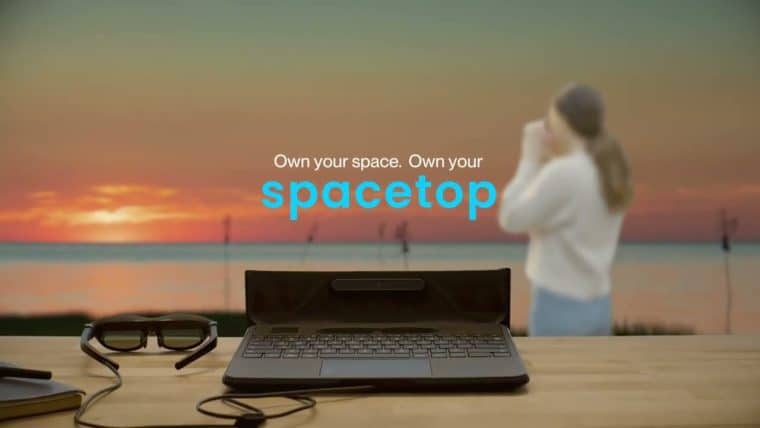
Startup Sightful is shaking up the laptop market with its new Spacetop device, which gets rid of the screen to create a 100-inch virtual display using augmented reality.
The laptop best appeals to those working on the go as it offers a private, large display without the hassle of carrying a bulky monitor.
The Spacetop is priced at $2,000 and comes with an optimized Arm processor, an open-source Android operating system, and a custom headset, according to a report by The Verge.
Wistron, a Chinese Original Design Manufacturer that creates laptops for other brands, has built the Spacetop.
The device has a chassis that measures 10.47 inches wide and 9.8 inches deep and weighs 3.3 pounds including the headset.
The base is thicker than a conventional laptop at 1.57 inches, and the device is built around a Snapdragon 865 from 2019 with 8GB of RAM and 256GB of storage.
The Spacetop supports several wireless features including 5G NR Sub-6, Wi-Fi 6, Bluetooth 5.1, and has a 2560×1920 webcam, fingerprint reader, and 10Gbps USB-C ports with DisplayPort 1.4 capabilities.
“We are looking forward to the day when we forget about the laptops we have today,” Sightful CEO Tamir Berliner said, claiming that the new device is the future of computing.
“If you go to Best Buy tomorrow and you see a 13-inch laptop, and a 15-inch laptop, and a 100-inch laptop that’s the size of a 13-incher, which would you buy?”
Spacetop’s Headset Delivers 1080p Resolution Per Eye
The most crucial hardware of the Spacetop is the headset itself. It delivers 1080p resolution per eye at 72Hz and weighs only 106 grams, which is about one-quarter of Microsoft’s almost-defunct HoloLens weight.
The Spacetop provides a 53-degree diagonal field of view, making it an excellent compromise between focusing on a task and being aware of surroundings.
The Spacetop resolution (1720×1890 pixels) is less than the Meta Quest, designed for virtual reality, but it’s still impressive in augmented reality.
Sightful’s Spacetop headset also supports interpupillary distances between 56mm and 70mm, and the company can personalize lenses for users who have a prescription.
Nevertheless, it’s not possible to use glasses with the headset. The headset’s most user-friendly feature is the three-finger swipe up and down on the touchpad that brings the curved screen closer or further away.
Spacetop Offers an Experience Similar to a Laptop
The experience for users is similar to a laptop. Users navigate through the device on the trackpad and resize windows, repositioning them on the screen.
The most innovative thing about the Spacetop is that it can be “pinned” to a given location, then recalled to the laptop by tapping both Shift keys simultaneously.
However, the battery life is just over five hours, and the small speakers sound tinny and faint, with low volume designed to maintain privacy.
Furthermore, the laptop’s performance was not up to par during the demo session, and the device reportedly crashed early on and had to be rebooted.
Scrolling and resizing windows were slow, and attempts to play a YouTube video caused the browser to freeze.
The reason is that the device is powered by the Qualcomm Snapdragon 865, an 8-core chipset that was announced back in 2019.
The first batch of units, limited to 1,000 early adopters, will be exclusively for web-centric workloads. Anyone looking to use this device for gaming or video editing, for example, is currently out of luck.
Read More:
- Framework Laptops Impress – Every Part Can Be Repaired, Replaced or Upgraded in Sustainability Win
- US vs. China Chip War Escalates – Micron Products Subject to Chinese Cybersecurity Review
What's the Best Crypto to Buy Now?
- B2C Listed the Top Rated Cryptocurrencies for 2023
- Get Early Access to Presales & Private Sales
- KYC Verified & Audited, Public Teams
- Most Voted for Tokens on CoinSniper
- Upcoming Listings on Exchanges, NFT Drops